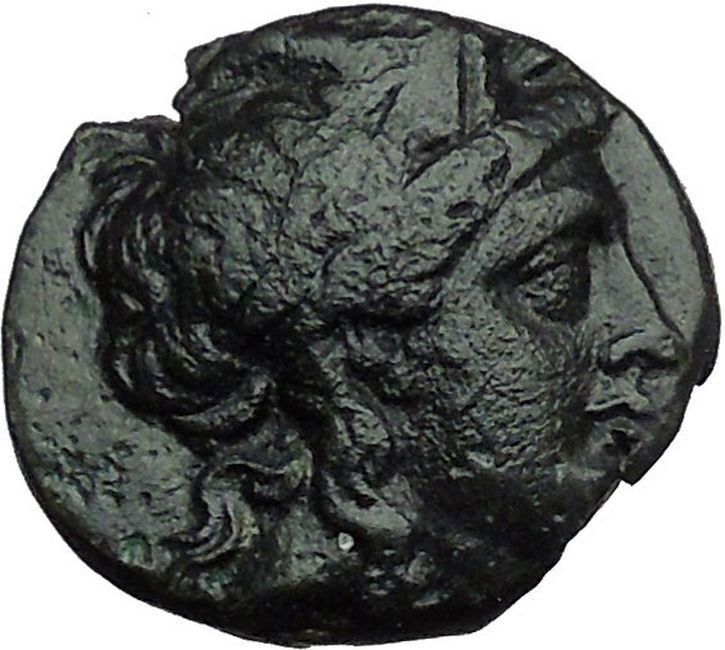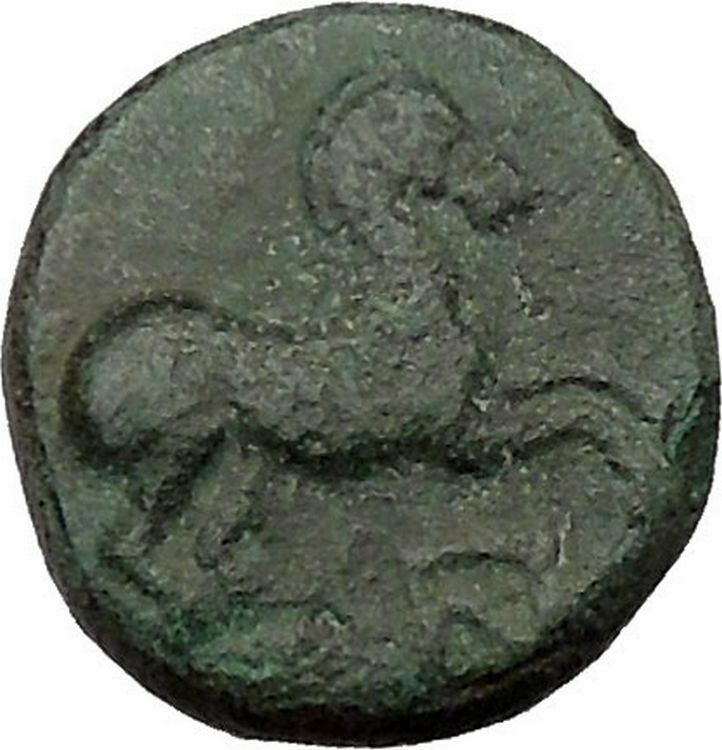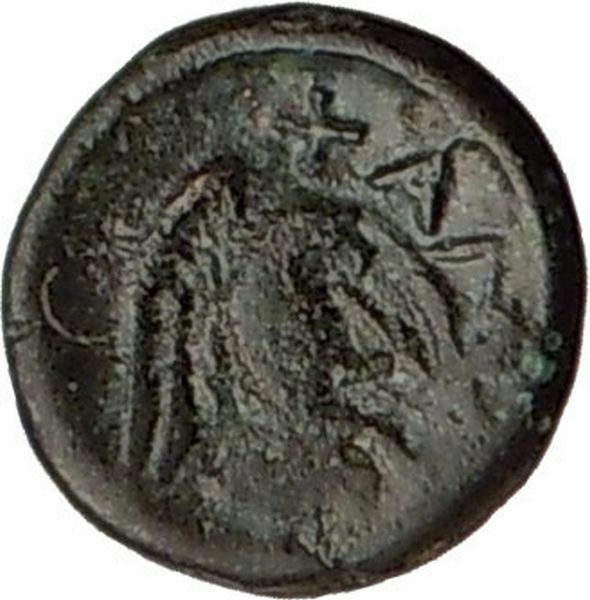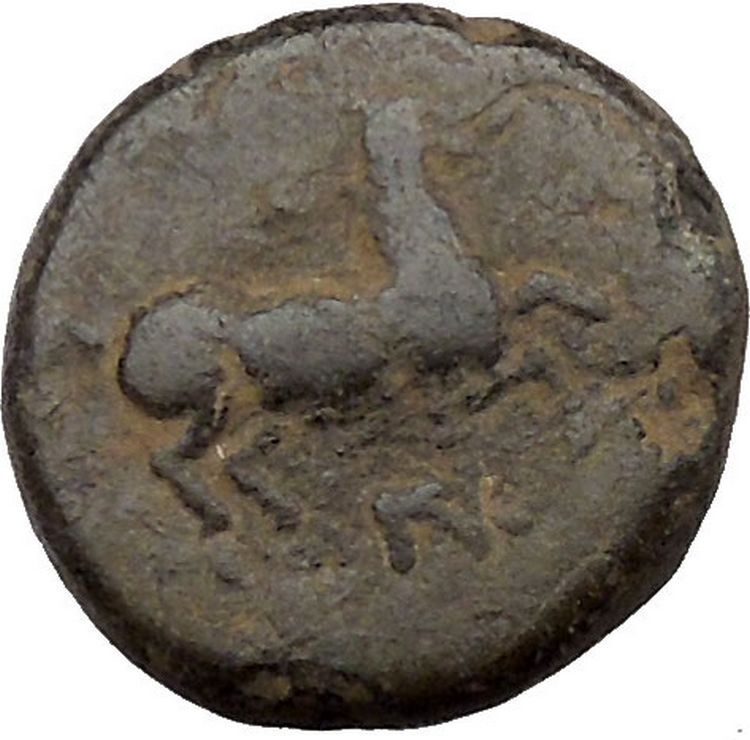|
Greek city of Lysimacheia in Thrace
Bronze 19mm (5.87 grams) Struck 309-220 B.C.
Reference: SNG Copenhagen 909-12 var.
Laureate head of Apollo right.
ΛYΣΙΜΑXΕΩΝ, Lion seated right.
Founded by Lysimachos in 309
B.C., close to the site of Kardia which he had destroyed, this city became the
principal residence and European mint of the King of Thrace.
You are bidding on the exact item pictured,
provided with a Certificate of Authenticity and Lifetime Guarantee of
Authenticity.

Apollo Belvedere
,
ca. 120–140 CE
Apollo is one of the most important and complex of the
Olympian deities
in
ancient Greek
and
Roman religion
,
Greek
and
Roman mythology
, and
Greco
–Roman
Neopaganism
. The ideal of the
kouros
(a beardless, athletic youth),
Apollo has been variously recognized as a god of light and the sun, truth and
prophecy, healing, plague, music, poetry, and more. Apollo is the son of
Zeus and Leto
, and has a twin sister, the chaste
huntress Artemis
. Apollo is known in Greek-influenced
Etruscan mythology
as Apulu.
As the patron of Delphi
(Pythian Apollo), Apollo was an
oracular
god—the prophetic deity of the
Delphic Oracle
. Medicine and healing are
associated with Apollo, whether through the god himself or mediated through his
son Asclepius
, yet Apollo was also seen as a god
who could bring ill-health and deadly
plague
. Amongst the god’s custodial charges,
Apollo became associated with dominion over
colonists
, and as the patron defender of herds
and flocks. As the leader of the
Muses (Apollon Musegetes) and director of their choir, Apollo
functioned as the patron god of music and poetry.
Hermes
created the
lyre for him, and the instrument became a common
attribute of Apollo
. Hymns sung to Apollo were
called paeans
.
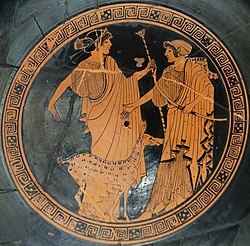
Apollo (left) and
Artemis
.
Brygos
(potter signed), Tondo of an
Attic red-figure cup c. 470 BC,
Musée du Louvre
.
In Hellenistic times, especially during the 3rd century BCE, as Apollo
Helios he became identified among Greeks with
Helios
,
Titan
god of the sun
, and his sister Artemis
similarly equated with
Selene
, Titan
goddess of the moon
In Latin texts, on the
other hand,
Joseph Fontenrose
declared himself unable to
find any conflation of Apollo with
Sol
among the
Augustan poets
of the 1st century, not even in
the conjurations of Aeneas
and
Latinus
in
Aeneid
XII (161–215). Apollo and Helios/Sol
remained separate beings in literary and mythological texts until the 3rd
century CE.
Etymology

Statuette of the Apollo Lykeios type,
Museum of the Ancient Agora of Athens
(inv. BI 236).
Apollo was worshipped throughout the
Roman Empire
. In the traditionally
Celtic
lands he was most often seen as a
healing and sun god. He was often equated with
Celtic gods
of similar character.
Apollo Atepomarus
(“the great horseman”
or “possessing a great horse”). Apollo was worshipped at
Mauvières
(Indre).
Horses were, in the Celtic world, closely linked to the sun.[23]
Apollo Belenus
(‘bright’ or
‘brilliant’). This epithet was given to Apollo in parts of
Gaul
, Northern Italy and
Noricum
(part of modern Austria). Apollo
Belenus was a healing and sun god.[24]
Apollo Cunomaglus
(‘hound lord’). A
title given to Apollo at a shrine in
Wiltshire
. Apollo Cunomaglus may have been
a god of healing. Cunomaglus himself may originally have been an independent
healing god.[25]
Apollo Grannus
. Grannus was a healing
spring god, later equated with Apollo.- Apollo Maponus. A god known from inscriptions in Britain. This
may be a local fusion of Apollo and
Maponus
.
Apollo Moritasgus
(‘masses of sea
water’). An epithet for Apollo at Alesia, where he was worshipped as god of
healing and, possibly, of physicians.
Apollo Vindonnus
(‘clear light’).
Apollo Vindonnus had a temple at
Essarois
, near
Châtillon-sur-Seine
in
Burgundy
. He was a god of healing,
especially of the eyes.
Apollo Virotutis
(‘benefactor of
mankind?’). Apollo Virotutis was worshipped, among other places, at Fins
d’Annecy (Haute-Savoie)
and at Jublains
(Maine-et-Loire).
Origins

The Omphalos
in the Museum of
Delphi
.
The cult centers of Apollo in Greece,
Delphi
and
Delos
, date from the 8th century BCE. The Delos
sanctuary was primarily dedicated to
Artemis
, Apollo’s twin sister. At Delphi,
Apollo was venerated as the slayer of
Pytho
. For the Greeks, Apollo was all the Gods
in one and through the centuries he acquired different functions which could
originate from different gods. In
archaic Greece
he was the
prophet
, the oracular god who in older times
was connected with “healing”. In
classical Greece
he was the god of light and of
music, but in popular religion he had a strong function to keep away evil.
From his eastern-origin Apollo brought the art of inspection from “symbols
and omina
” (σημεία και τέρατα : semeia kai
terata), and of the observation of the
omens of the days. The inspiration oracular-cult was probably
introduced from Anatolia
. The
ritualism
belonged to Apollo from the
beginning. The Greeks created the
legalism
, the supervision of the orders of the
gods, and the demand for moderation and harmony. Apollo became the god of
shining youth, the protector of music, spiritual-life, moderation and
perceptible order. The improvement of the old
Anatolian
god, and his elevation to an
intellectual sphere, may be considered an achievement of the
Greek
people.
Healer and
god-protector from evil
The function of Apollo as a “healer” is connected with
Paean
, the physician of the Gods in the
Iliad
, who seems to come from a more
primitive religion. Paeοn is probably connected with the
Mycenean
Pa-ja-wo, but the etymology is the
only evidence. He did not have a separate cult, but he was the personification
of the holy magic-song sung by the magicians that was supposed to cure disease.
Later the Greeks knew the original meaning of the relevant song “paean”. The
magicians were also called “seer-doctors”, and they used an ecstatic prophetic
art which was used exactly by the god Apollo at the oracles.
In the Iliad, Apollo is the healer under the gods, but he is also the
bringer of disease and death with his arrows, similar to the function of the
terrible
Vedic
god of disease
Rudra
.He sends a terrible plague to the
Achaeans
. The god who sends a disease can also
prevent from it, therefore when it stops they make a purifying ceremony and
offer him an “hecatomb” to ward off evil. When the oath of his priest appeases,
they pray and with a song they call their own god, the beautiful Paean.
Some common epithets of Apollo as a healer are “paion” , “epikourios”, “oulios”,
and “loimios” . In classical times, his strong function in popular religion was
to keep away evil, and was therefore called “apotropaios” and “alexikakos” ,
throw away the evil).
In later writers, the word, usually spelled “Paean”, becomes a
mere epithet of Apollo in his capacity as a god of
healing
.
Homer illustrated Paeon the god, and the song both of
apotropaic
thanksgiving or triumph. Such songs
were originally addressed to Apollo, and afterwards to other gods: to
Dionysus
, to Apollo
Helios
, to Apollo’s son
Asclepius
the healer. About the 4th century
BCE, the paean became merely a formula of adulation; its object was either to
implore protection against disease and misfortune, or to offer thanks after such
protection had been rendered. It was in this way that Apollo had become
recognised as the god of music. Apollo’s role as the slayer of the
Python
led to his association with battle and
victory; hence it became the
Roman
custom for a paean to be sung by an army
on the march and before entering into battle, when a fleet left the harbour, and
also after a victory had been won.
Dorian origin
The connection with Dorians and their initiation festival
apellai
is reinforced by the month
Apellaios in northwest Greek calendars, but it can explain only the Doric
type of the name, which is connected with the
Ancient Macedonian
word “pella” (Pella),
stone. Stones played an important part in the cult of the god, especially
in the oracular shrine of Delphi (Omphalos).
The “Homeric hymn” represents Apollo as a Northern intruder. His arrival must
have occurred during the “dark ages” that followed the destruction of the
Mycenaean civilization
, and his conflict with
Gaia
(Mother Earth) was represented by the
legend of his slaying her daughter the serpent
Python
.
The earth deity had power over the ghostly world, and it is believed that she
was the deity behind the oracle. The older tales mentioned two dragons who were
perhaps intentionally conflated. A female dragon named
Delphyne
who is obviously connected with Delphi
and Apollo Delphinios, and a male serpent
Typhon
, the adversary of
Zeus in the
Titanomachy
, who the narrators confused with
Python
. Python was the good daemon of the
temple as it appears in
Minoan
religion, but she was represented as a
dragon, as often happens in Northern European folklore as well as in the East.
Apollo and his sister
Artemis
can bring death with their arrows. The
conception that diseases and death come from invisible shots sent by
supernatural beings, or magicians is common in
Germanic
and
Norse
mythology.[35]
In
Greek mythology
Artemis was the leader of the
nymphs
, who had similar functions with the
Nordic
Elves.The “elf-shot” originally indicated disease or death attributed
to the elves, but it was later attested denoting
arrow
-heads which were used by witches to harm
people, and also for healing rituals.
The
Vedic
Rudra has some similar functions with
Apollo. The terrible god is called “The Archer”, and the bow is also an
attribute of Shiva
. Rudra could bring diseases with his
arrows, but he was able to free people of them, and his alternative Shiba, is a
healer physician god. However the
Indo-European
component of Apollo, does not
explain his strong relation with omens, exorcisms, and with the oracular cult.
Minoan origin
It seems an oracular cult existed in Delphi from the
Mycenaean
ages.[53]
In historical times, the priests of Delphi were called
Labryaden
, “the double-axe men”, which
indicates
Minoan
origin. The double-axe (λάβρυς:labrys)
was the holy symbol of the
Cretan
labyrinth
.[54][55]
The Homeric hymn adds that Apollo appeared as a dolphin and carried Cretan
priests to Delphi, where they evidently transferred their religious practices.
Apollo Delphinios was a sea-god especially worshiped in Crete and in the
islands, and his name indicates his connection with Delphi[56]
and the holy serpent
Delphyne
(womb). Apollo’s sister
Artemis
, who was the Greek goddess of hunting,
is identified with
Britomartis
(Diktynna),
the
Minoan
“Mistress of the animals”. In her
earliest depictions she is accompanied by the “Mister of the animals”, a male
god of hunting who had the bow as his attribute. We don’t know his original
name, but it seems that he was absorbed by the more powerful Apollo, who stood
by the “Mistress of the animals”, becoming her brother.[49]
The old oracles in Delphi seem to be connected with a local tradition of the
priesthood, and there is not clear evidence that a kind of inspiration-prophecy
existed in the temple. This led some scholars to the conclusion that Pythia
carried on the rituals in a consistent procedure through many centuries,
according to the local tradition. In that regard, the mythical seeress
Sibyl
of
Anatolian
origin, with her ecstatic art, looks
unrelated to the oracle itself.[57]
However, the Greek tradition is referring to the existence of vapours and
chewing of laurel-leaves, which seem to be confirmed by recent studies.[58]
Plato
describes the priestesses of Delphi and
Dodona
as frenzied women, obsessed by “mania” (μανία:frenzy),
a Greek word connected with “mantis” (μάντις:prophet). Frenzied women like
Sibyls from whose lips the god speaks are recorded in the
Near East
as
Mari
in the second millennium BC.[59]
Although Crete had contacts with Mari from 2000 BC,[60]
there is no evidence that the ecstatic prophetic art existed during the Minoan
and Mycenean ages. It is more probable that this art was introduced later from
Anatolia
and regenerated an existing oracular
cult that was local to Delphi and dormant in several areas of Greece.[61]
Anatolian origin
A non-Greek origin of Apollo has long been assumed in scholarship.[3]
The name of Apollo’s mother
Leto has Lydian
origin, and she was worshipped on the
coasts of
Asia Minor
. The inspiration oracular cult was
probably introduced into Greece from
Anatolia
, which is the origin of
Sibyl
, and where existed some of the oldest
oracular shrines. Omens, symbols, purifications, and exorcisms appear in old
Assyro
–Babylonian
texts, and these rituals were spread into the empire of the
Hittites
. In a Hittite text is mentioned that
the king invited a Babylonian priestess for a certain “purification”.[33]
A similar story is mentioned by
Plutarch
. He writes that the
Cretan
–
seer
Epimenides
, purified
Athens
after the pollution brought by the
Alcmeonidae
, and that the seer’s expertise in
sacrifices
and reform of funeral practices were
of great help to Solon
in his reform of the Athenian state.[62]
The story indicates that Epimenides was probably heir to the shamanic religions
of Asia, and proves together with the
Homeric
hymn, that Crete had a resisting
religion up to the historical times. It seems that these rituals were dormant in
Greece, and they were reinforced when the Greeks migrated to
Anatolia
.
Homer
pictures Apollo on the side of the
Trojans, fighting against the
Achaeans
, during the
Trojan War
. He is pictured as a terrible god,
less trusted by the Greeks than other gods. The god seems to be related to
Appaliunas, a tutelary god of
Wilusa
(Troy)
in Asia Minor, but the word is not complete.[63]
The stones found in front of the gates of
Homeric
Troy were the symbols of Apollo. The
Greeks gave to him the name αγυιεύς
agyieus
as the protector god of public places
and houses who wards off evil, and his symbol was a tapered stone or column.[64]
However, while usually Greek festivals were celebrated at the
full moon
, all the feasts of Apollo were
celebrated at the seventh day of the month, and the emphasis given to that day (sibutu)
indicates a
Babylonian
origin.[65]
The
Late Bronze Age
(from 1700 to 1200 BCE)
Hittite
and
Hurrian
Aplu was a god of
plague
, invoked during plague years. Here we
have an
apotropaic
situation, where a god originally
bringing the plague was invoked to end it. Aplu, meaning the son of, was
a title given to the god
Nergal
, who was linked to the
Babylonian
god of the sun
Shamash
.[12]
Homer interprets Apollo as a terrible god (δεινός θεός) who brings death and
disease with his arrows, but who can also heal, possessing a magic art that
separates him from the other Greek gods.[66]
In Iliad
, his priest prays to Apollo
Smintheus,[67]
the mouse god who retains an older agricultural function as the protector from
field rats.[68][69]
All these functions, including the function of the healer-god
Paean
, who seems to have Mycenean origin, are
fused in the cult of Apollo.
Oracular cult

Columns of the
Temple of Apollo
at Delphi, Greece.
Unusually among the Olympic deities, Apollo had two cult sites that had
widespread influence: Delos
and
Delphi
. In cult practice,
Delian Apollo
and
Pythian Apollo
(the Apollo of Delphi) were so
distinct that they might both have shrines in the same locality.[70]
Apollo’s
cult
was already fully established when written
sources commenced, about 650 BCE. Apollo became extremely important to the Greek
world as an oracular deity in the
archaic period
, and the frequency of
theophoric names
such as Apollodorus or
Apollonios and cities named Apollonia testify to his popularity.
Oracular sanctuaries to Apollo were established in other sites. In the 2nd and
3rd century CE, those at
Didyma
and
Clarus
pronounced the so-called “theological
oracles”, in which Apollo confirms that all deities are aspects or servants of
an
all-encompassing, highest deity
. “In the 3rd
century, Apollo fell silent.
Julian the Apostate
(359 – 61) tried to revive
the Delphic oracle, but failed
Thrace is a historical and geographic area in southeast
Europe
. As a geographical concept, Thrace
designates a region bounded by the
Balkan Mountains
on the north,
Rhodope Mountains
and the
Aegean Sea
on the south, and by the
Black Sea
and the
Sea of Marmara
on the east. The areas it
comprises are southeastern
Bulgaria
(Northern
Thrace), northeastern
Greece
(Western
Thrace), and the European part of
Turkey
(Eastern
Thrace). The biggest part of Thrace is part of present-day Bulgaria.
In Turkey, it is also called
Rumelia
. The name comes from the
Thracians
, an ancient
Indo-European
people inhabiting Southeastern
Europe.
The historical boundaries of Thrace have varied. Noteworthy is the fact that,
at an early date, the
ancient Greeks
employed the term “Thrace” to
refer to all of the territory which lay north of
Thessaly
inhabited by the
Macedoniaa
Thracians
and even
Scythia
) were added.[2]
Danubee on the north, by the Euxine Sea (Black
Sea) on the east, by northern
Macedonia
in the south and by the
Illyrian
lands (i.e.
Illyria
) to the west.[2]
This largely coincided with the Thracian
Odrysian kingdom
, whose borders varied in time.
During this time, specifically after the Macedonian conquest, the region’s old
border with Macedonia was shifted from the
Struma River
to the
Roman province of Thracee
Mesta River
was of this extent,
but after the administrative reforms of the late 3rd century, Thracia’s much
reduced territory became the six small provinces which constituted the
Diocese of Thrace
. The medieval
Byzantine
theme
of
Thrace
contained only what today is
Eastern Thrace
.
The largest cities of Thrace are:
İstanbul
(European side),
Plovdiv
,
Burgas
,
Stara Zagora
,
Haskovo
,
Edirne
,
Çorlu
and
Tekirdag
.
Most of the Bulgarian and Greek population are Christians, while most of the
Turkish inhabitants of Thrace are Muslims.
Thrace in
ancient Greek mythology
Ancient Greek mythology
provides them with a
mythical ancestor, named
Thrax
, son of the war-god
Ares, who was said to reside in Thrace. The Thracians appear in
Homer
‘s
Iliad
as
Trojan allies, led by
Acamas
and
Peiros
. Later in the Iliad,
Rhesus
, another Thracian king, makes an
appearance. Cisseus
, father-in-law to the Trojan elder
Antenor
, is also given as a Thracian king.
Homeric Thrace was vaguely defined, and stretched from the River
Axios
in the west to the
Hellespont
and
Black Sea
in the east. The
Catalogue of Ships
mentions three separate
contingents from Thrace: Thracians led by Acamas and Peiros, from
Aenus
;
Cicones
led by
Euphemus
, from southern Thrace, near
Ismaros
; and from the city of
Sestus
, on the Thracian (northern) side of the
Hellespont, which formed part of the contingent led by
Asius
. Greek mythology is replete with Thracian
kings, including
Diomedes
,
Tereus
,
Lycurgus
,
Phineus
,
Tegyrius
,
Eumolpus
,
Polymnestor
,
Poltys
, and
Oeagrus
(father of
Orpheus
). In addition to the tribe that Homer
calls Thracians, ancient Thrace was home to numerous other tribes, such as the
Edones
,
Bisaltae
,
Cicones
, and
Bistones
.
Thrace is also mentioned in Ovid’s Metamorphoses in the episode of
Philomela
, Procne, and
Tereus
. Tereus, the King of Thrace, lusts after
his sister-in-law, Philomela. He kidnaps her, holds her captive, rapes her, and
cuts out her tongue. Philomela manages to get free, however. She and her sister,
Procne, plot to get revenge, by killing Itys (son of Tereus and Procne) and
serving him to his father for dinner. At the end of the myth, all three turn
into birds—Procne, a swallow; Philomela, a nightingale; and Tereus, a
hoopoe
.
History
Ancient history
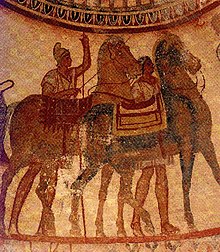
Thracian Tomb of Kazanlak
The indigenous population of Thrace was a people called the
Thracians
, divided into numerous tribal groups.
Thracian troops were known to accompany neighboring ruler
Alexander the Great
when he crossed the
Hellespont
which abuts Thrace, and took on the
Persian Empire
of the day.
The Thracians did not describe themselves as such and Thrace and
Thracians<!– are simply the names given them by the Greeks.
Divided into separate tribes, the Thracians did not manage to form a lasting
political organization until the e
Odrysian state
was founded in the 4th century
BC. Like Illyrians
, Thracian tribes of the mountainous
regions fostered a locally ruled warrior tradition, while the tribes based in
the plains were purportedly more peaceable. Recently discovered funeral mounds
in Bulgaria suggest that Thracian kings did rule regions of Thrace with distinct
Thracian national identity.
During this period, a subculture of
celibate
ascetics
called the
Ctistae
lived in Thrace, where they served as
philosophers, priests and prophets.
Medieval history
By the mid 5th century, as the Roman Empire began to crumble, Thracia fell
from the authority of Rome and into the hands of Germanic tribal rulers. With
the fall of Rome, Thracia turned into a battleground territory for the better
part of the next 1,000 years. The eastern successor of the
Roman Empire
in the Balkans, the
Byzantine Empire
, retained control over Thrace
until the 8th century when the northern half of the entire region was
incorporated into the
First Bulgarian Empire
. Byzantium regained
Thrace in the late 10th century and administered it as a
theme
, until the Bulgarians regained
control of the northern half at the end of the 12th century. Throughout the 13th
century and the first half of the 14th century, the region was changing in the
hands of the Bulgarian and the Byzantine Empire(excl. Constantinopole). In 1265
the area suffered a Mongol raid from the
Golden Horde
, led by
Nogai Khan
. In 1352, the
Ottoman
Turks
conducted their first incursion into the
region subduing it completely within a matter of two decades and occupying it
for five centuries.
Modern history
With the
Congress of Berlin
in 1878, Northern Thrace was
incorporated into the semi-autonomous Ottoman province of
Eastern Rumelia
, which united with Bulgaria in
1885. The rest of Thrace was divided among Bulgaria, Greece and Turkey at the
beginning of the 20th century, following the
Balkan Wars
,
World War I
and the
Greco-Turkish War
. Today Thracian is a
strong regional identity in Greece, Turkey, Bulgaria and other neighbouring
countries.
Famous Thracians and people from Thrace
- A number of
Roman emperors
Thraco-Roman backgrounds (Maximinus
Thrax,
Licinius
,
Galerius
,
Aureolus
,
Leo the Thracian
, etc.). These emperors
were elevated via a military career, from the condition of common soldiers
in one of the
Roman legions
to the foremost positions of
political power
.
|











